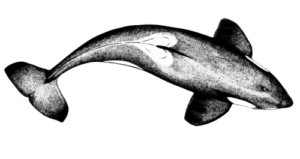
FAQ
If your question is not listed below don’t hesitate to contact us
As traveling in arctic can not be improvised
How to join us
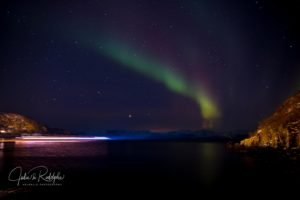
We suggest you to organize your flights to Tromso, international airport (TOS) or rent a car to Skjervoy around 4 -5 hours by driving from the airport. But the ferry is the best, easiest and safest way.
Airport to ferry 10m by Taxi and around 60€ one way for the ferry to Seglvik via Skjervoy.
If your expedition starts on a Friday evening the ferry leaves tromso at 16.00 don’t be late! You will be back to Tromso either on Tuesday or Friday, depending on the length of your expedition, at 21.15.
If you expedition starts on a Tuesday, the bus will be leaving at 9 am from Tromsø scandic ishavshotel and back by ferry to Tromso at 21.15.
The island name is Segvlik at 12nm north of skjervoy only accessible by boat.
Weather & Clothing
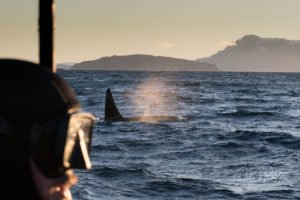
Weather & Clothing
Norway is located at the same latitude as Greenland, Alaska, and Siberia, but because of the Gulf Stream, the climate here is considerably more pleasant.
During winter, Northern Norway’s arctic coastline averages temperatures a little under 0°C, but it can get as cold as -10°C Don’t worry, with plenty of extra layers, you will be warm and cozy enough to enjoy the refreshing arctic air.
Recommendations
Merino wool base layers (tops and long-johns) and socks are highly recommended. Appropriate winter clothing should be windproof, waterproof and hefty enough to withstand the elements and keep you warm. Don’t forget warm winter boots, a wool cap, gloves and a scarf.
We propose fishing warm & waterproof gloves and boots for sale onsite
We more than recommend to also have a waterproof bag for all electronic equipment to protect them from the rough sea and waves. In any way we cannot be held responsible for damaged equipment.
Clothing Included
We provide you with a warm overall suit of the brand Drysuit during our sea excursions.
Our Snorkle Material
Imersion wet suits of 10mm .
Mask & Tuba & Fins Cressi Brand
Gloves 5mm Imersion
Boots 7mm Cressi
Weight + Belt
Any material damaged or lost will be charged
Diving in Arctic

We do snorkling with whales and with wet suits of 10mm. Even though the suits are very floatable we ask our guests to be in a good health condition, to be comfortable in the water as a swimmer and have already a snorkeling experience.
BE AWARE sea conditions can be tough.
There is no limit to the number of dives.
The air temperature is between 8- 4°C
The water temperature is between 6 to 4°C
Because of the rough weather and our open boats we don’t accept children under 16 years old (only in condition you wish to privatise the boat)
Arctic Light
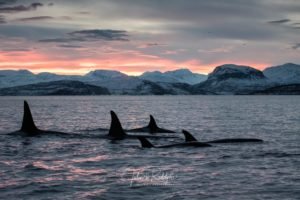
Capture the moment
The blue morning light and a blood red sun below the horizon deliver a unique spectrum of lighting possibilities.
But always make sure to hurry up, for the days are short here:
At 9am you can see the moon in the sky, at 10 dawn sets in, at 11 it’s bright and at 3pm it gets dusky again to going full dark at 4pm.
22nd of December is the darkest day of the year. From then it’s gets a bit brighter every day with five to six hours of daylight in January.
You have never seen a comparable light anywhere else. This light alone is worth a trip to northern Norway in winter.
On Land
There is a lot to discover here on our arctic island: admire the northern lights, meet some fishermen, campfire inside the traditional Lavvu (Sami tent), BBQ or just have a chat or play in the whale house. After a day at sea, why not take advantage of our sauna and jacuzzi under the arctic lights?
For wildlife enthusiasts, you can admire the flight of eagles, the families of otters who come regularly to our small port or the otters and stoats who visit us.
We have plenty of surprises in store for you to make your stay an exceptional one.
Accommodation
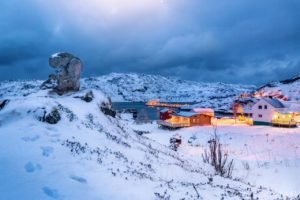
We live North of the Fjord away of all, you will be living in a typical Norwegian shared house with shared bathrooms.
These houses are used by the owners a summer homes
Your breakfast and tea time will be shared in the “Whale House” all together in front of the Fjord and Dinners in the Lavvu which is heated.
Beware there are NO shops, hotels, bars … only us 🙂
Only accessible by boat
No Wifi But great telephone 4G connection
Do you propose snorkelling day tours?
We do not propose snorkeling day trips as we wish to share a minimum time with you to fully live this expedition and create lifetime memories together. We also think it is important to take time to participate to our outings among the animals in full awareness of their habitat with gentleness and respect.
We believe in running ethical, safe, and low-pressure operations which not only offer the best experience for you but also places an even higher priority on the well-being of the animals we are fortunate enough to encounter. Do remember also, you are in the Arctic : weather conditions can be complicated and rough, that snorkeling can’t be done every day…Making a one-day snorkle trip difficult to fulfill your dream.
We are also dependant on ferry schedules making it impossible for shorter stays as day trips.
If needed, we are happy to advise you companies proposing whale watching day tours from Skjervoy.
Do whale watching tours affect whales' behaviour'
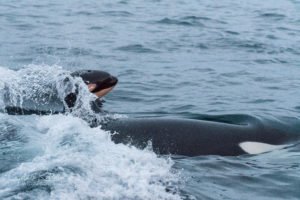
Our priority is to minimalize the disturbance that could occur for the animal, keep the welfare of the animals and respect a safe distance. Our captains will approach slowly and sideways never from the front or rear.
According on our experience
The captain is the only one taking the decision of maybe leaving the area if too many boats are around them.
Photo shoot Tips
Northern lights
What you need:
A quality tripod
Wide angle lens focus to infinity
Set the aperture as wide as possible (lowest number as your les goes)
5-15 seconds exposure
ISO 800 ad if very dark increase 1600-3200 or more but bigger chance of “grain” in your pictures
And ofcourse go outside several times! Sometimes they only last couple of minutes
Iphone 11 do also amazing photos!
Underwater / Top side
Your boat captain will expertly position the RIB boat to help maximize the light when capturing images of whales, birds or landscapes
As the light conditions are very low in the Arctic, orcas with their ,black and white color make contrast zones and they are big and fast as dolphins , photos can be quite a challenge !
Shutter speed
we recommend observers to use the ‘Shutter priority’ mode to photograph whales. Ideally, a minimum shutter speed of 1/800s should be set in order to freeze the whale in motion. If light conditions are good enough, it is possible to increase the shutter speed even more. Shooting with too low shutter speeds would lead to motion blur.
Aperture
When shooting under the ‘Shutter priority’ mode, the camera adjusts the aperture automatically, based on available light and to fulfill the input speed settings. During the winter months in Arctic Norway, and because the sun remains below the horizon, only poor light is available for a couple of hours a day. These conditions constitute a real challenge for photographing dark moving subjects such as whales. Therefore, shooting with a f/2.8 telephoto zoom, which transfers much more light than regular lenses, is recommended.
ISO
ISO setting is used to compensate poor light conditions. However, it is worth remembering that increasing ISO also increases noise on photographs, resulting in killer whales’ features becoming undistinguishable. Most camera bodies can handle ISO values up to 640 to 800, with full frame cameras being better at handling high ISO. We advice photographers to test the limits of their camera in various light conditions beforehand. We also do not recommend using the automatic ISO setting, which can potentially lead to wrong choices and ruin photographs.
*The use of external lights (strobes,flashs..) are not allowed as they may stress animals
